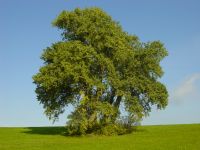
Researchers study poplar genetics for biofuels
March 5, 2010
By Canadian Biomass
 |

|
Mar. 5, 2010, College Park, MD – An interdisciplinary team of researchers from the
University of Maryland and Bowie State University is working on ways to turn
poplar trees into high-yielding crops for biofuels, including cellulosic
ethanol. The hybrid trees would be grown on plantations. The study is funded by
a $3.2-million, four-year grant from the National Science Foundation's Plant
Genome Research Project, which supports research on plants seen as having
economic and agricultural importance. Researchers Gary Coleman, Ganesh Sriram,
and Jianhua Zhu of Maryland and George Ude of Bowie State are using the
recently completed poplar genome to look for ways to improve the tree's
nitrogen processing capability, which would enhance its growth rate and
feasibility for use in fuel production.
"We
need to develop an alternative crop that we use exclusively for biofuels and
not food," explains Sriram, assistant professor of chemical and
biomolecular engineering at the University of Maryland's A. James Clark School
of Engineering. Enter poplar (also known as cottonwood or aspen), which is
already commonly cultivated for the production of paper and timber. "What
we want are trees like poplar that grow fast and efficiently so they can become
the raw material for cellulosic biofuel," says Sriram.
Simply
growing acres of poplar trees to convert into biofuel isn't enough to solve
current fuel problems. Researchers already know how to make ethanol from
fibrous plants, but for poplar to be truly effective as a biofuel source, its
growth cycle needs to speed up and become more efficient. One of the keys to
doing so is to understand how it stores and cycles nitrogen because nitrogen is
an important factor in the growth and productivity of trees and crops.
The
fertilizers that help produce big harvests are rich in nitrogen but are
expensive and must be reapplied each year. Poplar is a perennial plant, capable
of pulling nitrogen from its leaves, storing it through the winter, and
redistributing it in the spring. And while a crop like corn must be replanted
each year, a poplar tree is capable of re-growing itself from its roots after
being cut, and can go through several cycles of growth and harvest throughout
its life before a new tree needs to replace it.
"Both
the growth in the spring and re-growth from roots after the stems are harvested
depend on the availability of stored nitrogen," lead researcher Coleman
explains. "The data we collect will allow us to understand mechanisms of
nitrogen cycling, determine how to increase the rates of the cellular
reactions, and identify the genes that play a crucial role in the process.
Eventually, we should be able to breed a variety of poplar with a more
efficient nitrogen process, optimized for growth and rapid maturity."
The
research team are examining how the thousands of genes in poplar are being
switched on and off during the nitrogen storage cycle, measuring the rates of
dozens of chemical reactions, and studying the many proteins that facilitate all
of the activity. "What we're looking for is the most efficient way for
these plants to process nitrogen," says Sriram.
The team's
large-scale study of woody plants for use in biofuel production has only
recently been made possible by the availability of the poplar tree's genome,
which is a map of its complete genetic structure. "We're one of the first
groups to work on nitrogen cycling and metabolism in poplar," says Sriram.
"We expect to produce a large amount of unprecedented information about
the way nitrogen moves around and is stored in a tree."
Print this page